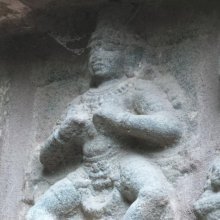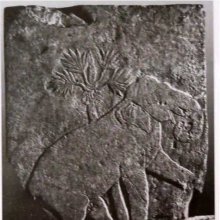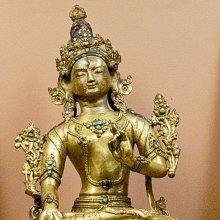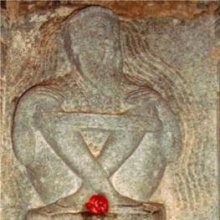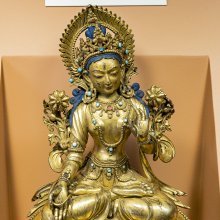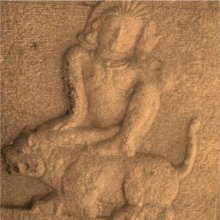Palm: 2 definitions
Introduction:
Palm means something in Hinduism, Sanskrit. If you want to know the exact meaning, history, etymology or English translation of this term then check out the descriptions on this page. Add your comment or reference to a book if you want to contribute to this summary article.
Images (photo gallery)
(+44 more images available)
In Hinduism
Shilpashastra (iconography)
Source: Shodhganga: Elements of Art and Architecture in the Trtiyakhanda of the Visnudharmottarapurana (shilpa)The Palm is denoted by the Sanskrit term Karatala, and represents one of the various body parts whose Measurements should follow the principles of ancient Indian Painting (citra), according to the Viṣṇudharmottarapurāṇa, an ancient Sanskrit text which (being encyclopedic in nature) deals with a variety of cultural topics such as arts, architecture, music, grammar and astronomy.—In the third part of the Viṣṇudharmottarapurāṇa, chapters 35th to 43rd are dedicated to the Painting of different portraits of different kinds of men and women. The measurement of almost all the body parts that should be maintained in a picture have been presented here. For example, the Palm (karatala) should be 12 aṅgulas.

Shilpashastra (शिल्पशास्त्र, śilpaśāstra) represents the ancient Indian science (shastra) of creative arts (shilpa) such as sculpture, iconography and painting. Closely related to Vastushastra (architecture), they often share the same literature.
Yoga (school of philosophy)
Source: ORA: Amanaska (king of all yogas): A Critical Edition and Annotated Translation by Jason BirchThe Palm (of one’s hands) is denoted by the Sanskrit term Tala, according to the Parākhyatantra verse 14.8-9.—Accordingly, while discussing preliminary practices to make the Yogin ready to undertake the six auxiliaries of Śaiva yoga: “He should adopt one of these [four poses], placing his hands with the palms (tala) arranged [facing upwards] in his own lap, expanding his chest evenly. Slightly closing his two eyes, he should focus on the tip of his nose. Remaining thus he is fit for yoga and he should then begin its sequence”.

Yoga is originally considered a branch of Hindu philosophy (astika), but both ancient and modern Yoga combine the physical, mental and spiritual. Yoga teaches various physical techniques also known as āsanas (postures), used for various purposes (eg., meditation, contemplation, relaxation).
See also (Relevant definitions)
Starts with (+71): Pal-muttuval, Palm grass, Palm lily, Palm nut tree, Palm tree, Palm-leaf, Palma, Palma africana, Palma andante, Palma barrigona, Palma christi, Palma cola de pescado, Palma da dattero, Palma de aceite, Palma de cacho, Palma de escoba, Palma de vino, Palma di san pier martire, Palma di san pietro, Palma nana.
Ends with (+130): African fan palm, African oil palm, African palmyra palm, African wild date palm, American oil palm, Areca nut palm, Areca palm, Areng palm, Assai palm, Australian ivy palm, Bamboo palm, Bass palm, Bergpalm, Betel nut palm, Betel palm, Bitter rattan palm, Black palm, Blue palm, Borassus palm, Breadpalm.
Full-text (+2563): Tala, Karatala, Anjali, Panitala, Dhvajadruma, Acamana, Kritanjali, Hastatala, Drumashreshtha, Hintala, Tali, Padmarekha, Pharpharika, Prapani, Baddhanjali, Onjhala, Dirghataru, Talaphala, Kurcashiras, Trinaraj.
Relevant text
Search found 282 books and stories containing Palm; (plurals include: Palms). You can also click to the full overview containing English textual excerpts. Below are direct links for the most relevant articles:
Vinaya Pitaka (3): Khandhaka (by I. B. Horner)
Rejection of wooden sandals < [5. Leather (Camma)]
On Bimbisāra’s gathering < [1. Going forth (Pabbajjā)]
Procedure for making amends for offences < [2. Observance (Uposatha)]
Vinaya Pitaka (2): Bhikkhuni-vibhanga (the analysis of Nun’ rules) (by I. B. Horner)
Brihad Bhagavatamrita (commentary) (by Śrī Śrīmad Bhaktivedānta Nārāyana Gosvāmī Mahārāja)
Verse 2.1.47 < [Chapter 1 - Vairāgya (renunciation)]
Verse 2.4.16-17 < [Chapter 4 - Vaikuṇṭha (the spiritual world)]
Verse 2.2.112 < [Chapter 2 - Jñāna (knowledge)]
Egypt Through The Stereoscope (by James Henry Breasted)
Position 38 - The Winnowing Of The Grain After Threshing < [Standpoints In Egypt]
Position 33 - Dahabiyehs On The River Ready For The Journey To The Upper Nile < [Standpoints In Egypt]
Position 24 - Looking Down The Main Passage Leading To Khufu's Sepulcher Within The Great Pyramid < [Standpoints In Egypt]
Kathasaritsagara (the Ocean of Story) (by Somadeva)
Part 16 - The Marianne Islands < [Appendix 8.2 - The Romance of Betel-Chewing]
Part 12 - Southern China < [Appendix 8.2 - The Romance of Betel-Chewing]
Part 4 - Assam, Burma, Annam and Siam < [Appendix 8.2 - The Romance of Betel-Chewing]
The Jataka tales [English], Volume 1-6 (by Robert Chalmers)
Jataka 322: Daddabha-jātaka < [Volume 3]
Jataka 55: Pañcāvudha-jātaka < [Book I - Ekanipāta]
Jataka 95: Mahāsudassana-jātaka < [Book I - Ekanipāta]
Related products
(+41 more products available)
